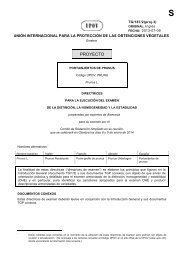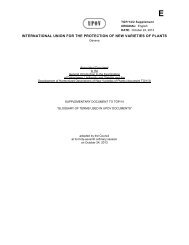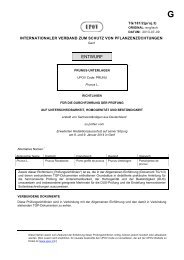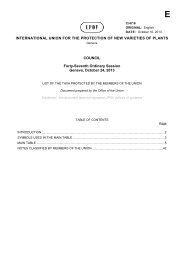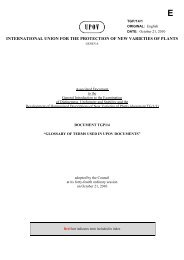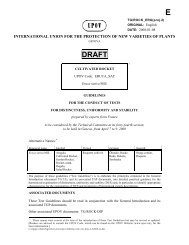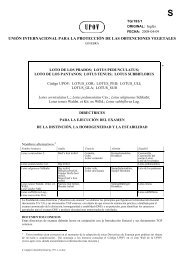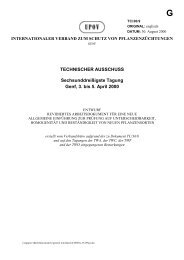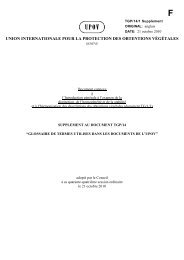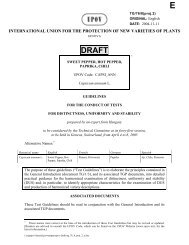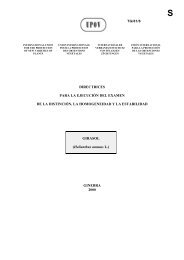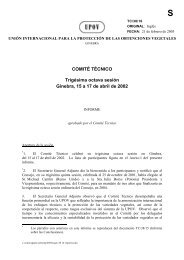E - International Union for the Protection of New Varieties of Plants
E - International Union for the Protection of New Varieties of Plants
E - International Union for the Protection of New Varieties of Plants
Create successful ePaper yourself
Turn your PDF publications into a flip-book with our unique Google optimized e-Paper software.
TG/53/7(proj.2)<br />
ORIGINAL: English<br />
DATE: 2010-02-10<br />
INTERNATIONAL UNION FOR THE PROTECTION OF NEW VARIETIES OF PLANTS<br />
GENEVA<br />
Alternative Names: *<br />
DRAFT<br />
PEACH<br />
UPOV Code: PRUNU_PER<br />
Prunus persica (L.) Batsch<br />
GUIDELINES<br />
FOR THE CONDUCT OF TESTS<br />
FOR DISTINCTNESS, UNIFORMITY AND STABILITY<br />
prepared by an expert from France<br />
to be considered by <strong>the</strong><br />
Technical Committee at its <strong>for</strong>ty-sixth session,<br />
to be held in Geneva from March 22 to 24, 2010<br />
Botanical name English French German Spanish<br />
Prunus persica (L.) Batsch,<br />
Persica vulgaris Mill.,<br />
Prunus L. subg. Persica<br />
Peach Pêcher Pfirsich Durazno,<br />
Melocotonero<br />
The purpose <strong>of</strong> <strong>the</strong>se guidelines (“Test Guidelines”) is to elaborate <strong>the</strong> principles contained in<br />
<strong>the</strong> General Introduction (document TG/1/3), and its associated TGP documents, into detailed<br />
practical guidance <strong>for</strong> <strong>the</strong> harmonized examination <strong>of</strong> distinctness, uni<strong>for</strong>mity and stability<br />
(DUS) and, in particular, to identify appropriate characteristics <strong>for</strong> <strong>the</strong> examination <strong>of</strong> DUS<br />
and production <strong>of</strong> harmonized variety descriptions.<br />
ASSOCIATED DOCUMENTS<br />
These Test Guidelines should be read in conjunction with <strong>the</strong> General Introduction, its<br />
associated TGP documents and <strong>the</strong> Test Guidelines <strong>for</strong> Prunus Rootstocks,<br />
document TG/187/1.<br />
* These names were correct at <strong>the</strong> time <strong>of</strong> <strong>the</strong> introduction <strong>of</strong> <strong>the</strong>se Test Guidelines but may be revised or updated.<br />
[Readers are advised to consult <strong>the</strong> UPOV Code, which can be found on <strong>the</strong> UPOV Website (www.upov.int), <strong>for</strong> <strong>the</strong><br />
latest in<strong>for</strong>mation.]<br />
*<br />
E
TG/53/7(proj.2)<br />
Peach, 2010-02-10<br />
- 2 -<br />
TABLE OF CONTENTS PAGE<br />
1. SUBJECT OF THESE TEST GUIDELINES..................................................................................................3<br />
2. MATERIAL REQUIRED ...............................................................................................................................3<br />
3. METHOD OF EXAMINATION.....................................................................................................................3<br />
3.1 Number <strong>of</strong> Growing Cycles ....................................................................................................................3<br />
3.2 Testing Place...........................................................................................................................................3<br />
3.3 Conditions <strong>for</strong> Conducting <strong>the</strong> Examination...........................................................................................3<br />
3.4 Test Design .............................................................................................................................................4<br />
3.5 Number <strong>of</strong> <strong>Plants</strong> / Parts <strong>of</strong> <strong>Plants</strong> to be Examined.................................................................................4<br />
3.6 Additional Tests ......................................................................................................................................4<br />
4. ASSESSMENT OF DISTINCTNESS, UNIFORMITY AND STABILITY...................................................4<br />
4.1 Distinctness .............................................................................................................................................4<br />
4.2 Uni<strong>for</strong>mity...............................................................................................................................................5<br />
4.3 Stability ...................................................................................................................................................5<br />
5. GROUPING OF VARIETIES AND ORGANIZATION OF THE GROWING TRIAL.................................5<br />
6. INTRODUCTION TO THE TABLE OF CHARACTERISTICS...................................................................6<br />
6.1 Categories <strong>of</strong> Characteristics...................................................................................................................6<br />
6.2 States <strong>of</strong> Expression and Corresponding Notes.......................................................................................6<br />
6.3 Types <strong>of</strong> Expression................................................................................................................................6<br />
6.4 Example <strong>Varieties</strong> ...................................................................................................................................6<br />
6.5 Legend.....................................................................................................................................................6<br />
7. TABLE OF CHARACTERISTICS/TABLEAU DES<br />
CARACTÈRES/MERKMALSTABELLE/TABLA DE CARACTERES.......................................................7<br />
8. EXPLANATIONS ON THE TABLE OF CHARACTERISTICS ................................................................25<br />
8.1 Explanations covering several characteristics.......................................................................................25<br />
8.2 Explanations <strong>for</strong> individual characteristics ...........................................................................................25<br />
9. LITERATURE ..............................................................................................................................................45<br />
10. TECHNICAL QUESTIONNAIRE ...............................................................................................................47
1. Subject <strong>of</strong> <strong>the</strong>se Test Guidelines<br />
TG/53/7(proj.2)<br />
Peach, 2010-02-10<br />
- 3 -<br />
These Test Guidelines apply to all varieties <strong>of</strong> peach (including nectarine) <strong>of</strong> <strong>the</strong><br />
species Prunus persica (L.) Batsch. For <strong>the</strong> examination <strong>of</strong> hybrids involving Prunus persica<br />
(L.) Batsch, guidance is provided in document TGP/13 “Guidance <strong>for</strong> <strong>New</strong> Types and<br />
Species”.<br />
2. Material Required<br />
2.1 The competent authorities decide on <strong>the</strong> quantity and quality <strong>of</strong> <strong>the</strong> plant material<br />
required <strong>for</strong> testing <strong>the</strong> variety and when and where it is to be delivered. Applicants<br />
submitting material from a State o<strong>the</strong>r than that in which <strong>the</strong> testing takes place must ensure<br />
that all customs <strong>for</strong>malities and phytosanitary requirements are complied with.<br />
2.2 The material is to be supplied in <strong>the</strong> <strong>for</strong>m <strong>of</strong> grafted trees, on a peach rootstock to be<br />
selected by <strong>the</strong> competent authorities.<br />
2.3 The minimum quantity <strong>of</strong> plant material, to be supplied by <strong>the</strong> applicant, should be:<br />
5 grafted trees.<br />
2.4 The plant material supplied should be visibly healthy, not lacking in vigor, nor<br />
affected by any important pest or disease.<br />
2.5 The plant material should not have undergone any treatment which would affect <strong>the</strong><br />
expression <strong>of</strong> <strong>the</strong> characteristics <strong>of</strong> <strong>the</strong> variety, unless <strong>the</strong> competent authorities allow or<br />
request such treatment. If it has been treated, full details <strong>of</strong> <strong>the</strong> treatment must be given.<br />
3. Method <strong>of</strong> Examination<br />
3.1 Number <strong>of</strong> Growing Cycles<br />
The minimum duration <strong>of</strong> tests should normally be two independent growing cycles.<br />
In particular, it is essential that <strong>the</strong> trees produce a satisfactory crop <strong>of</strong> fruit in each <strong>of</strong> <strong>the</strong> two<br />
growing cycles.<br />
3.2 Testing Place<br />
Tests are normally conducted at one place. In <strong>the</strong> case <strong>of</strong> tests conducted at more than<br />
one place, guidance is provided in TGP/9 “Examining Distinctness”.<br />
3.3 Conditions <strong>for</strong> Conducting <strong>the</strong> Examination<br />
3.3.1 The tests should be carried out under conditions ensuring satisfactory growth <strong>for</strong> <strong>the</strong><br />
expression <strong>of</strong> <strong>the</strong> relevant characteristics <strong>of</strong> <strong>the</strong> variety and <strong>for</strong> <strong>the</strong> conduct <strong>of</strong> <strong>the</strong><br />
examination.<br />
3.3.2 Because daylight varies, color determinations made against a color chart should be<br />
made ei<strong>the</strong>r in a suitable cabinet providing artificial daylight or in <strong>the</strong> middle <strong>of</strong> <strong>the</strong> day in a<br />
room without direct sunlight. The spectral distribution <strong>of</strong> <strong>the</strong> illuminant <strong>for</strong> artificial daylight<br />
should con<strong>for</strong>m with <strong>the</strong> CIE Standard <strong>of</strong> Preferred Daylight D 6500 and should fall within
TG/53/7(proj.2)<br />
Peach, 2010-02-10<br />
- 4 -<br />
<strong>the</strong> tolerances set out in <strong>the</strong> British Standard 950, Part I. These determinations should be<br />
made with <strong>the</strong> plant part placed against a white background.<br />
3.4 Test Design<br />
3.4.1 Each test should be designed to result in a total <strong>of</strong> at least 5 trees.<br />
3.4.2 The design <strong>of</strong> <strong>the</strong> tests should be such that plants or parts <strong>of</strong> plants may be removed<br />
<strong>for</strong> measurement or counting without prejudice to <strong>the</strong> observations which must be made up to<br />
<strong>the</strong> end <strong>of</strong> <strong>the</strong> growing cycle.<br />
3.5 Number <strong>of</strong> <strong>Plants</strong> / Parts <strong>of</strong> <strong>Plants</strong> to be Examined<br />
Unless o<strong>the</strong>rwise indicated, all observations should be made on 5 plants or parts taken<br />
from each <strong>of</strong> 5 plants. In <strong>the</strong> case <strong>of</strong> parts <strong>of</strong> plants, <strong>the</strong> number to be taken from each <strong>of</strong> <strong>the</strong><br />
plants should be 2.<br />
3.6 Additional Tests<br />
Additional tests, <strong>for</strong> examining relevant characteristics, may be established.<br />
4. Assessment <strong>of</strong> Distinctness, Uni<strong>for</strong>mity and Stability<br />
4.1 Distinctness<br />
4.1.1 General Recommendations<br />
It is <strong>of</strong> particular importance <strong>for</strong> users <strong>of</strong> <strong>the</strong>se Test Guidelines to consult <strong>the</strong> General<br />
Introduction prior to making decisions regarding distinctness. However, <strong>the</strong> following points<br />
are provided <strong>for</strong> elaboration or emphasis in <strong>the</strong>se Test Guidelines.<br />
4.1.2 Consistent Differences<br />
The differences observed between varieties may be so clear that more than one<br />
growing cycle is not necessary. In addition, in some circumstances, <strong>the</strong> influence <strong>of</strong> <strong>the</strong><br />
environment is not such that more than a single growing cycle is required to provide<br />
assurance that <strong>the</strong> differences observed between varieties are sufficiently consistent. One<br />
means <strong>of</strong> ensuring that a difference in a characteristic, observed in a growing trial, is<br />
sufficiently consistent is to examine <strong>the</strong> characteristic in at least two independent growing<br />
cycles.<br />
4.1.3 Clear Differences<br />
Determining whe<strong>the</strong>r a difference between two varieties is clear depends on many<br />
factors, and should consider, in particular, <strong>the</strong> type <strong>of</strong> expression <strong>of</strong> <strong>the</strong> characteristic being<br />
examined, i.e. whe<strong>the</strong>r it is expressed in a qualitative, quantitative, or pseudo-qualitative<br />
manner. There<strong>for</strong>e, it is important that users <strong>of</strong> <strong>the</strong>se Test Guidelines are familiar with <strong>the</strong><br />
recommendations contained in <strong>the</strong> General Introduction prior to making decisions regarding<br />
distinctness.
4.2 Uni<strong>for</strong>mity<br />
TG/53/7(proj.2)<br />
Peach, 2010-02-10<br />
- 5 -<br />
4.2.1 It is <strong>of</strong> particular importance <strong>for</strong> users <strong>of</strong> <strong>the</strong>se Test Guidelines to consult <strong>the</strong> General<br />
Introduction prior to making decisions regarding uni<strong>for</strong>mity. However, <strong>the</strong> following points<br />
are provided <strong>for</strong> elaboration or emphasis in <strong>the</strong>se Test Guidelines:<br />
4.2.2 For <strong>the</strong> assessment <strong>of</strong> uni<strong>for</strong>mity, a population standard <strong>of</strong> 1% and an acceptance<br />
probability <strong>of</strong> at least 95% should be applied. In <strong>the</strong> case <strong>of</strong> a sample size <strong>of</strong> 5 plants,<br />
no <strong>of</strong>f-types are allowed.<br />
4.3 Stability<br />
4.3.1 In practice, it is not usual to per<strong>for</strong>m tests <strong>of</strong> stability that produce results as certain as<br />
those <strong>of</strong> <strong>the</strong> testing <strong>of</strong> distinctness and uni<strong>for</strong>mity. However, experience has demonstrated<br />
that, <strong>for</strong> many types <strong>of</strong> variety, when a variety has been shown to be uni<strong>for</strong>m, it can also be<br />
considered to be stable.<br />
4.3.2 Where appropriate, or in cases <strong>of</strong> doubt, stability may be tested, ei<strong>the</strong>r by growing a<br />
fur<strong>the</strong>r generation, or by testing a new plant stock to ensure that it exhibits <strong>the</strong> same<br />
characteristics as those shown by <strong>the</strong> previous material supplied.<br />
5. Grouping <strong>of</strong> <strong>Varieties</strong> and Organization <strong>of</strong> <strong>the</strong> Growing Trial<br />
5.1 The selection <strong>of</strong> varieties <strong>of</strong> common knowledge to be grown in <strong>the</strong> trial with <strong>the</strong><br />
candidate varieties and <strong>the</strong> way in which <strong>the</strong>se varieties are divided into groups to facilitate<br />
<strong>the</strong> assessment <strong>of</strong> distinctness are aided by <strong>the</strong> use <strong>of</strong> grouping characteristics.<br />
5.2 Grouping characteristics are those in which <strong>the</strong> documented states <strong>of</strong> expression, even<br />
where produced at different locations, can be used, ei<strong>the</strong>r individually or in combination with<br />
o<strong>the</strong>r such characteristics: (a) to select varieties <strong>of</strong> common knowledge that can be excluded<br />
from <strong>the</strong> growing trial used <strong>for</strong> examination <strong>of</strong> distinctness; and (b) to organize <strong>the</strong> growing<br />
trial so that similar varieties are grouped toge<strong>the</strong>r.<br />
5.3 The following have been agreed as useful grouping characteristics:<br />
(a) Flower: type (characteristic 9)<br />
(b) Petiole: shape <strong>of</strong> nectaries (characteristic 31)<br />
(c) Fruit: pubescence <strong>of</strong> skin (characteristic 45)<br />
(d) Fruit: carotenoid coloration <strong>of</strong> flesh (characteristic 52)<br />
(e) Fruit: acidity (Acidity titrable) in meq 100/ml (characteristic 58) with <strong>the</strong><br />
following groups:<br />
- low<br />
- medium<br />
- high<br />
(f) Fruit: flesh type (TQ characteristic), with <strong>the</strong> following groups:<br />
- melting<br />
- non-melting (pavies)<br />
- stony hard<br />
(g) Stone: adherence to flesh (characteristic 65)<br />
(h) Time <strong>of</strong> beginning <strong>of</strong> flowering (characteristic 68)<br />
(i) Time <strong>of</strong> maturity <strong>for</strong> consumption (characteristic 69)
TG/53/7(proj.2)<br />
Peach, 2010-02-10<br />
- 6 -<br />
5.4 Guidance <strong>for</strong> <strong>the</strong> use <strong>of</strong> grouping characteristics, in <strong>the</strong> process <strong>of</strong> examining<br />
distinctness, is provided through <strong>the</strong> General Introduction.<br />
6. Introduction to <strong>the</strong> Table <strong>of</strong> Characteristics<br />
6.1 Categories <strong>of</strong> Characteristics<br />
6.1.1 Standard Test Guidelines Characteristics<br />
Standard Test Guidelines characteristics are those which are approved by UPOV <strong>for</strong><br />
examination <strong>of</strong> DUS and from which members <strong>of</strong> <strong>the</strong> <strong>Union</strong> can select those suitable <strong>for</strong> <strong>the</strong>ir<br />
particular circumstances.<br />
6.1.2 Asterisked Characteristics<br />
Asterisked characteristics (denoted by *) are those included in <strong>the</strong> Test Guidelines<br />
which are important <strong>for</strong> <strong>the</strong> international harmonization <strong>of</strong> variety descriptions and should<br />
always be examined <strong>for</strong> DUS and included in <strong>the</strong> variety description by all members <strong>of</strong> <strong>the</strong><br />
<strong>Union</strong>, except when <strong>the</strong> state <strong>of</strong> expression <strong>of</strong> a preceding characteristic or regional<br />
environmental conditions render this inappropriate.<br />
6.2 States <strong>of</strong> Expression and Corresponding Notes<br />
States <strong>of</strong> expression are given <strong>for</strong> each characteristic to define <strong>the</strong> characteristic and to<br />
harmonize descriptions. Each state <strong>of</strong> expression is allocated a corresponding numerical note<br />
<strong>for</strong> ease <strong>of</strong> recording <strong>of</strong> data and <strong>for</strong> <strong>the</strong> production and exchange <strong>of</strong> <strong>the</strong> description.<br />
6.3 Types <strong>of</strong> Expression<br />
An explanation <strong>of</strong> <strong>the</strong> types <strong>of</strong> expression <strong>of</strong> characteristics (qualitative, quantitative<br />
and pseudo-qualitative) is provided in <strong>the</strong> General Introduction.<br />
6.4 Example <strong>Varieties</strong><br />
Where appropriate, example varieties are provided to clarify <strong>the</strong> states <strong>of</strong> expression <strong>of</strong><br />
each characteristic.<br />
6.5 Legend<br />
(*) Asterisked characteristic – see Chapter 6.1.2<br />
QL: Qualitative characteristic – see Chapter 6.3<br />
QN: Quantitative characteristic – see Chapter 6.3<br />
PQ: Pseudo-qualitative characteristic – see Chapter 6.3<br />
(a)-(g) See Explanations on <strong>the</strong> Table <strong>of</strong> Characteristics in Chapter 8.1<br />
(+) See Explanations on <strong>the</strong> Table <strong>of</strong> Characteristics in Chapter 8.2
1.<br />
(*)<br />
TG/53/7(proj.2)<br />
Peach/Pêcher/Pfirsich/Durazno, Melocotonero, 2010-02-10<br />
- 7 -<br />
7. Table <strong>of</strong> Characteristics/Tableau des caractères/Merkmalstabelle/Tabla de caracteres<br />
English<br />
français<br />
deutsch<br />
español<br />
Tree: size Arbre: taille Baum: Größe Árbol: tamaño<br />
Example <strong>Varieties</strong>/<br />
Exemples/<br />
Beispielssorten/<br />
Variedades ejemplos<br />
QN (a) very small très petit sehr klein muy pequeño Bonanza 1<br />
2.<br />
(+)<br />
small petit klein pequeño Richaven 3<br />
medium moyen mittel mediano Robin 5<br />
large grand groß grande Redhaven 7<br />
very large très grand sehr groß muy grande Champion 9<br />
Tree: vigor Arbre: vigueur Baum: Wuchsstärke Árbol: vigor<br />
QN (b) weak faible gering débil J. H. Hale 3<br />
3.<br />
(*)<br />
(+)<br />
medium moyenne mittel medio Robin 5<br />
strong <strong>for</strong>te stark fuerte Springtime 7<br />
Tree: habit Arbre: port Baum: Wuchs<strong>for</strong>m Árbol: porte<br />
QN (a) upright dressé aufrecht erecto Nectarose, Pillar 1<br />
4.<br />
(+)<br />
upright to spreading dressé à étalé aufrecht bis<br />
breitwüchsig<br />
erecto hacia<br />
extendido<br />
Note/<br />
Nota<br />
Fairhaven, Redwing 2<br />
spreading étalé breitwüchsig extendido Albertina,<br />
Elegant Lady, O’Henry<br />
drooping retombant überhängend colgante TO BE REPLACED 4<br />
weeping très retombant lang überhängend llorón Biancopendulo 5<br />
Flowering shoot:<br />
thickness<br />
Rameau mixte:<br />
grosseur<br />
Blütentrieb: Dicke Rama floral: grosor<br />
QN (a) thin fin dünn delgada Mayred 3<br />
medium moyen mittel media Redhaven 5<br />
thick gros dick gruesa Flavorcrest, Lizzie 7<br />
3
English<br />
5. Flowering shoot:<br />
length <strong>of</strong> internodes<br />
TG/53/7(proj.2)<br />
Peach/Pêcher/Pfirsich/Durazno, Melocotonero, 2010-02-10<br />
- 8 -<br />
français<br />
Rameau mixte:<br />
longueur des<br />
entrenœuds<br />
deutsch<br />
Blütentrieb: Länge<br />
der Internodien<br />
español<br />
Rama floral:<br />
longitud de los<br />
intranudos<br />
Example <strong>Varieties</strong>/<br />
Exemples/<br />
Beispielssorten/<br />
Variedades ejemplos<br />
QN (a) very short très courts sehr kurz muy cortos Bonanza 1<br />
(d) short courts kurz cortos June Gold,<br />
Merrill Sundance<br />
medium moyens mittel medianos Redhaven 5<br />
long longs lang largos Fairhaven 7<br />
very long très longs sehr lang muy largos Flacara 9<br />
6. Flowering shoot:<br />
presence <strong>of</strong><br />
anthocyanin<br />
coloration<br />
7.<br />
(+)<br />
Rameau mixte :<br />
présence de<br />
la pigmentation<br />
anthocyanique<br />
Blütentrieb:<br />
Vorhandensein von<br />
Anthocyanfärbung<br />
Rama floral:<br />
presencia de<br />
pigmentación<br />
antociánica<br />
absent absente fehlend ausente De flor doble blanca 1<br />
present présente vorhanden presente 9<br />
Flowering shoot:<br />
intensity <strong>of</strong><br />
anthocyanin<br />
coloration<br />
Rameau mixte:<br />
intensité de la<br />
pigmentation<br />
anthocyanique<br />
Blütentrieb:<br />
Intensität der<br />
Anthocyanfärbung<br />
Rama floral:<br />
intensidad de la<br />
pigmentación<br />
antociánica<br />
QN (d) very weak très faible sehr gering muy débil TO BE REPLACED 1<br />
8.<br />
(+)<br />
weak faible gering débil Springtime 3<br />
medium moyenne mittel media Fuzalode 5<br />
strong <strong>for</strong>te stark fuerte Robin,<br />
Sanguine Chanas<br />
Flowering shoot:<br />
density <strong>of</strong> flower<br />
buds<br />
Rameau mixte:<br />
densité des boutons<br />
floraux<br />
Blütentrieb: Dichte<br />
der Blütenknospen<br />
Rama floral:<br />
densidad de los<br />
botones florales<br />
QN (a) very sparse très peu dense sehr locker muy laxa Monline 1<br />
(d) sparse peu dense locker laxa O’Henry, Zaitabo 3<br />
medium moyenne mittel media Craucail, Flacara,<br />
Michelini, Richlady<br />
dense dense dicht densa Momée 7<br />
very dense très dense sehr dicht muy densa Armking, Harco 9<br />
Note/<br />
Nota<br />
3<br />
7<br />
5
9.<br />
(*)<br />
(+)<br />
English<br />
TG/53/7(proj.2)<br />
Peach/Pêcher/Pfirsich/Durazno, Melocotonero, 2010-02-10<br />
- 9 -<br />
français<br />
deutsch<br />
español<br />
Flower: type Fleur: type Blüte: Typ Flor: tipo<br />
Example <strong>Varieties</strong>/<br />
Exemples/<br />
Beispielssorten/<br />
Variedades ejemplos<br />
QL (d) campanulate campanulée glockenförmig acampanada Dida, Springtime 1<br />
10.<br />
(*)<br />
(+)<br />
(e) rosette rosacée rosettenförmig roseta Robin, Vesuvio 2<br />
Corolla: main color<br />
(inner side)<br />
Corolle: couleur<br />
principale (face<br />
interne)<br />
Blütenkrone:<br />
vorwiegende Farbe<br />
(Innenseite)<br />
Corola: color<br />
principal (cara<br />
interna)<br />
PQ (d) white blanc weiß blanco Biancopendulo,<br />
De flor doble blanca<br />
11.<br />
(*)<br />
(+)<br />
(e) yellow pink TO BE jaune CHECKED/DELETED<br />
rosé gelbrosa rosa amarillento Hal<strong>for</strong>d 2<br />
very light pink rose très pale sehr hellrosa rosa muy claro Cardinal 3<br />
light pink rose pale hellrosa rosa claro Michelini 4<br />
medium pink rose moyen mittelrosa rosa medio Alexia, Fuzalode 5<br />
dark pink rose foncé dunkelrosa rosa oscuro Flacara, Vivian 6<br />
violet pink rose violacé violettrosa rosa violáceo Candor 7<br />
red rouge rot rojo Red Flower Peach 8<br />
Petal: shape Pétale: <strong>for</strong>me Blütenblatt: Form Pétalo: <strong>for</strong>ma<br />
PQ (d) narrow ovate ovale étroit schmal eiförmig oval estrecho TO BE PROVIDED 1<br />
(e) medium ovate ovale moyen mittel eiförmig oval medio TO BE PROVIDED 2<br />
narrow elliptic elliptique étroit schmal elliptisch elíptico estrecho TO BE PROVIDED 3<br />
medium elliptic elliptique moyen mittelmäßig elliptisch elíptico medio TO BE PROVIDED 4<br />
circular rond rund circular TO BE PROVIDED 5<br />
Note/<br />
Nota<br />
1
12.<br />
(+)<br />
English<br />
Only varieties with<br />
flower type:<br />
campanulate: Petal:<br />
width<br />
TG/53/7(proj.2)<br />
Peach/Pêcher/Pfirsich/Durazno, Melocotonero, 2010-02-10<br />
- 10 -<br />
français<br />
Seulement pour les<br />
variétés à fleurs<br />
campanulées :<br />
Pétale: largeur<br />
deutsch<br />
Nur Sorten mit<br />
glockenförmigem<br />
Blütentyp:<br />
Blütenblatt: Breite<br />
español<br />
Sólo variedades con<br />
tipo de flor:<br />
acampanada:<br />
Pétalo: anchura<br />
Example <strong>Varieties</strong>/<br />
Exemples/<br />
Beispielssorten/<br />
Variedades ejemplos<br />
QN (d) very narrow très étroit sehr schmal muy estrecho 1<br />
13.<br />
(*)<br />
(+)<br />
(e) narrow étroit schmal estrecho Meydicte 2<br />
medium moyen mittel medio Bradgust 3<br />
broad large breit ancho Monnail 4<br />
very broad très large sehr breit muy ancho 5<br />
Only varieties with<br />
flower type: rosette:<br />
Petal: width<br />
Seulement pour les<br />
variétés à fleurs en<br />
rosette : Pétale:<br />
largeur<br />
Nur Sorten mit<br />
rosettenförmigem<br />
Blütentyp:<br />
Blütenblatt: Breite<br />
Sólo variedades con<br />
tipo de flor: roseta:<br />
Pétalo: anchura<br />
QN (d) very narrow très étroit sehr schmal muy estrecho TO BE REPLACED 1<br />
14.<br />
(*)<br />
(e) small petit klein pequeño Shasta 2<br />
medium moyen mittel medio Robin 3<br />
broad large breit ancho Michelini 4<br />
very broad très large sehr breit muy ancho Veteran 5<br />
Flower: number <strong>of</strong><br />
petals<br />
Pétales: nombre de<br />
pétales<br />
Blütenblätter:<br />
Anzahl<br />
Flor: número de<br />
pétalos<br />
QL (d) five cinq fünf cinco Redhaven 1<br />
15.<br />
(+)<br />
(e) more than five plus de cinq mehr als fünf más de cinco Red Flower Peach,<br />
Royal Glo<br />
Stamen: position<br />
compared to petals<br />
Étamines: position<br />
par rapport aux<br />
pétales<br />
Staubgefäße:<br />
Stellung im<br />
Verhältnis zu den<br />
Blütenblättern<br />
Estambre: posición<br />
relativa a los pétalos<br />
QN (d) below au-dessous unterhalb por debajo Loring 1<br />
(e) at same level au même niveau auf gleicher Höhe en el mismo nivel Robin, Springtime 2<br />
above au-dessus oberhalb por encima Redhaven 3<br />
Note/<br />
Nota<br />
2
16.<br />
(*)<br />
(+)<br />
English<br />
TG/53/7(proj.2)<br />
Peach/Pêcher/Pfirsich/Durazno, Melocotonero, 2010-02-10<br />
- 11 -<br />
français<br />
Stigma: position Stigmate: position<br />
compared to an<strong>the</strong>rs par rapport aux<br />
anthères<br />
deutsch<br />
Narbe: Stellung im<br />
Verhältnis zu den<br />
An<strong>the</strong>ren<br />
español<br />
Estambre: posición<br />
relativa a las anteras<br />
Example <strong>Varieties</strong>/<br />
Exemples/<br />
Beispielssorten/<br />
Variedades ejemplos<br />
QN (d) below au-dessous unterhalb por debajo Vivian 1<br />
17.<br />
(*)<br />
(+)<br />
(e) same level au même niveau auf gleicher Höhe en el mismo nivel Crimson Gold 2<br />
above au-dessus oberhalb por encima Fuzalode 3<br />
An<strong>the</strong>rs: pollen Anthères: pollen An<strong>the</strong>ren: Pollen Anteras: polen<br />
QL (d) absent absent fehlend ausente J. H. Hale 1<br />
18.<br />
(*)<br />
(e) present présent vorhanden presente Redhaven 9<br />
Ovary: pubescence Ovaire: pubescence Fruchtknoten:<br />
Behaarung<br />
Ovario:<br />
pubescencia<br />
QL absent absente fehlend ausente Fuzalode 1<br />
19.<br />
(+)<br />
present présente vorhanden presente Redhaven 9<br />
Stipule: length (on<br />
fully expanded leaf<br />
on young shoot)<br />
Stipule: longueur<br />
(feuille<br />
complètement<br />
développée sur<br />
jeune rameau)<br />
Nebenblatt: Länge<br />
(am voll<br />
entwickelten Blatt<br />
am Jungtrieb)<br />
Estípula: longitud<br />
(hojas<br />
completamente<br />
extendidas en rama<br />
joven)<br />
QN (d) short court kurz corta Redhaven 3<br />
20.<br />
(*)<br />
(+)<br />
(e) medium moyen mittel media Robin 5<br />
long long lang larga Dixired 7<br />
Leaf blade: length Limbe longueur Blattspreite: Länge Limbo: longitud<br />
QN (b) short court kurz corto Jeronimo 3<br />
medium moyen mittel medio Fairhaven 5<br />
long long lang largo Southland 7<br />
Note/<br />
Nota
21.<br />
(*)<br />
(+)<br />
English<br />
TG/53/7(proj.2)<br />
Peach/Pêcher/Pfirsich/Durazno, Melocotonero, 2010-02-10<br />
- 12 -<br />
français<br />
deutsch<br />
español<br />
Leaf blade: width Limbe: largeur Blattspreite: Breite Limbo: anchura<br />
Example <strong>Varieties</strong>/<br />
Exemples/<br />
Beispielssorten/<br />
Variedades ejemplos<br />
QN (b) narrow étroit schmal estrecho Redhaven 3<br />
22.<br />
(*)<br />
(+)<br />
medium moyen mittel medio Robin 5<br />
broad large breit ancho Dixinel 7<br />
Leaf blade: ratio<br />
length/width<br />
Limbe: rapport<br />
longueur/largeur<br />
Blattspreite:<br />
Verhältnis<br />
Länge/Breite<br />
Limbo: relación<br />
longitud/anchura<br />
QN (b) low petit klein pequeña Mountaingold 3<br />
23.<br />
(+)<br />
medium moyen mittel media Early Sungrand 5<br />
high grand groß grande Springtime, Vivian 7<br />
Leaf blade: shape in<br />
cross section<br />
Limbe: <strong>for</strong>me en<br />
section transversale<br />
Blattspreite : Form<br />
im Querschnitt<br />
Limbo: <strong>for</strong>ma en<br />
sección transversal<br />
QL (b) concave concave konkav cóncavo Merrill Gemfree 1<br />
24.<br />
(+)<br />
flat droite eben plano Mayred 2<br />
Leaf blade: margin Limbe : bord Blattspreite: Rand Limbo: borde<br />
PQ (b) crenate crénelé gekerbt crenado Crimson Glo 1<br />
25.<br />
(+)<br />
shallow serrate denté peu pr<strong>of</strong>ond flach gesägt poco serrado Fiesta Red 2<br />
deep serrate denté pr<strong>of</strong>ond tief gesägt muy serrado Flor de Guaid 3<br />
Leaf blade: angle at<br />
base<br />
Limbe: angle au<br />
sommet<br />
Blattspreite: Winkel<br />
an der Basis<br />
Limbo: ángulo en la<br />
base<br />
QN (b) acute aigu spitz agudo Springtime 1<br />
right angle à angle droit rechtwinklig ángulo recto Redhaven 2<br />
obtuse obtus stumpf obtuso Merrill Fransiscan 3<br />
Note/<br />
Nota
26.<br />
(+)<br />
English<br />
Leaf blade: angle at<br />
apex<br />
TG/53/7(proj.2)<br />
Peach/Pêcher/Pfirsich/Durazno, Melocotonero, 2010-02-10<br />
- 13 -<br />
français<br />
Limbe: angle au<br />
sommet<br />
deutsch<br />
Blattspreite: Winkel<br />
an der Spitze<br />
español<br />
Limbo: ángulo en el<br />
ápice<br />
Example <strong>Varieties</strong>/<br />
Exemples/<br />
Beispielssorten/<br />
Variedades ejemplos<br />
QN (b) small petit klein pequeño Red June 3<br />
medium moyen mittel medio Earlired 5<br />
large grand groß grande Merrill Franciscan 7<br />
27. Leaf blade: color Limbe: couleur Blattspreite: Farbe Limbo: color<br />
PQ (b) greenish yellow jaune verdâtre grünlichgelb amarillo verdoso Redhaven 1<br />
28.<br />
(+)<br />
light green vert clair hellgrün verde claro Silver Fire 2<br />
medium green vert moyen mittelgrün verde medio Robin 3<br />
dark green vert foncé dunkelgrün verde oscuro Fiesta Red 4<br />
purplish red rouge pourpre purpurrot rojo purpúreo Rubira 5<br />
Leaf blade: red<br />
mid-vein on <strong>the</strong><br />
lower side<br />
Nervure principale<br />
rouge face<br />
inférieure<br />
Blattspreite: rote<br />
Hauptader auf der<br />
Unterseite<br />
Limbo: nervio<br />
central rojo en el<br />
envés<br />
QL (b) absent absente fehlend ausente Redhaven 1<br />
29.<br />
(+)<br />
present présente vorhanden presente Sanguine Chanas 9<br />
Petiole: length Pétiole: longueur Blattstiel: Länge Peciolo: longitud<br />
QN short court kurz corto Redhaven 3<br />
30.<br />
(*)<br />
(+)<br />
medium moyen mittel medio Genadix 7 5<br />
long long lang largo Andross 7<br />
Petiole: nectaries Pétiole: nectaires Blattstiel: Nektarien Peciolo: nectarios<br />
QL (c) absent absente fehlend ausente Crimson Glo, Tejon 1<br />
31.<br />
(*)<br />
(+)<br />
present présente vorhanden presente Redhaven 9<br />
Petiole: shape <strong>of</strong><br />
nectaries<br />
Pétiole: <strong>for</strong>me des<br />
nectaires<br />
Blattstiel: Form der<br />
Nektarien<br />
Peciolo: <strong>for</strong>ma de<br />
los nectarios<br />
QL (c) round circulaires rund circulares Springtime 1<br />
reni<strong>for</strong>m réni<strong>for</strong>mes nierenförmig reni<strong>for</strong>mes Redhaven 2<br />
Note/<br />
Nota
32.<br />
(*)<br />
English<br />
TG/53/7(proj.2)<br />
Peach/Pêcher/Pfirsich/Durazno, Melocotonero, 2010-02-10<br />
- 14 -<br />
français<br />
deutsch<br />
español<br />
Fruit: size Fruit: taille Frucht: Größe Fruto: tamaño<br />
Example <strong>Varieties</strong>/<br />
Exemples/<br />
Beispielssorten/<br />
Variedades ejemplos<br />
QN (f) very small très petit sehr klein muy pequeño Nectarine-Cerise 1<br />
33.<br />
(*)<br />
(+)<br />
small petit klein pequeño Minastar, Springtime 3<br />
medium moyen mittel mediano Momée, Springlady,<br />
Sunhaven<br />
large grand groß grande Bigtop, Loring,<br />
Royalglory<br />
very large très grand sehr groß muy grande Comanche, Maillarbig 9<br />
Fruit: shape (in<br />
ventral view)<br />
Fruit: <strong>for</strong>me (vue<br />
ventrale)<br />
Frucht: Form (in<br />
Bauchansicht)<br />
Fruto: <strong>for</strong>ma (en<br />
vista ventral)<br />
PQ (f) broad oblate aplati large breit abgeflacht achatado ancho Alex, Bailou, UFO3 1<br />
medium oblate moyennement aplati mittel abgeflacht achatado medio Herastrau, Robin 2<br />
circular rond rund circular Redwing 3<br />
broad elliptic elliptique large breit elliptisch elíptico ancho Cavalier 4<br />
elliptic elliptique elliptisch elíptico Elberta 5<br />
34. Fruit: mucron tip at<br />
pistil end<br />
Fruit : mucron à<br />
l’extrémité du pistil<br />
Frucht: aufgesetzte<br />
Spitze am<br />
Kelchende<br />
Fruto: punta del<br />
mucrón en el<br />
extremo del pistilo<br />
QL (f) absent absent fehlend ausente Robin 1<br />
present présent vorhanden presente Jersey Land,<br />
Spring time<br />
35. Fruit: shape <strong>of</strong> pistil<br />
end (without<br />
mucron tip)<br />
Fruit :<strong>for</strong>me de<br />
l’extrémité<br />
pistillaire (sans<br />
mucron)<br />
prominently pointed le plus souvent<br />
pointue<br />
Frucht: Form des<br />
Kelchendes (ohne<br />
aufgesetzte Spitze)<br />
Fruto: <strong>for</strong>ma del<br />
extremo del pistilo<br />
(sin la punta del<br />
mucrón)<br />
deutlich zugespitzt destacadamente<br />
puntiagudo<br />
weakly pointed faiblement pointue schwach zugespitzt débilmente<br />
puntiagudo<br />
Note/<br />
Nota<br />
TO BE REPLACED 1<br />
TO BE REPLACED 2<br />
flat plate flach plano Redhaven 3<br />
weakly depressed faiblement déprimée schwach eingesenkt débilmente hundido Robin 4<br />
strongly depressed <strong>for</strong>tement déprimée stark eingesenkt muy hundido Bailou , UFO3 5<br />
5<br />
7<br />
9
36.<br />
(+)<br />
English<br />
Fruit: symmetry<br />
(viewed from pistil<br />
end)<br />
TG/53/7(proj.2)<br />
Peach/Pêcher/Pfirsich/Durazno, Melocotonero, 2010-02-10<br />
- 15 -<br />
français<br />
Fruit: symétrie (vue<br />
de l’extrémité<br />
pistillaire)<br />
deutsch<br />
Frucht: Symmetrie<br />
(vom Kelchende aus<br />
gesehen)<br />
español<br />
Fruto: simetría<br />
(vista desde el<br />
extremo del pistilo)<br />
Example <strong>Varieties</strong>/<br />
Exemples/<br />
Beispielssorten/<br />
Variedades ejemplos<br />
QN (f) symmetric symétrique symmetrisch simétrico Redhaven 1<br />
37.<br />
(+)<br />
moderately<br />
asymmetric<br />
modérément<br />
asymétrique<br />
strongly asymmetric <strong>for</strong>tement<br />
asymétrique<br />
Fruit: prominence<br />
<strong>of</strong> suture<br />
Fruit : proéminence<br />
de la suture<br />
etwas asymmetrisch moderadamente<br />
asimétrico<br />
Brittaney Lane,<br />
Jim Dandy<br />
Note/<br />
Nota<br />
stark asymmetrisch muy asimétrico Precoccissima Moretini 3<br />
Frucht: Ausprägung<br />
der Naht<br />
Fruto: prominencia<br />
de la sutura<br />
QN (f) weak faible gering débil Redhaven 3<br />
38.<br />
(+)<br />
medium moyenne mittel media TO BE PROVIDED 5<br />
strong <strong>for</strong>te stark fuerte Precocissima Morettini 7<br />
Fruit: depth <strong>of</strong> stalk<br />
cavity<br />
Fruit: pr<strong>of</strong>ondeur<br />
de la cavité<br />
pédicellaire<br />
Frucht: Tiefe der<br />
Stielhöhe<br />
Fruto: pr<strong>of</strong>undidad<br />
de la cavidad<br />
peduncular<br />
QN (f) shallow peu pr<strong>of</strong>onde flach poco pr<strong>of</strong>unda Robin 3<br />
39.<br />
(+)<br />
medium moyenne mittel media Triumf 5<br />
deep pr<strong>of</strong>onde tief pr<strong>of</strong>unda Southland 7<br />
Fruit: width <strong>of</strong> stalk<br />
cavity<br />
Fruit: largeur de la<br />
cavité pédicellaire<br />
Frucht: Breite der<br />
Stielhöhe<br />
Fruto: anchura de<br />
la cavidad<br />
peduncular<br />
QN (f) narrow étroite schmal estrecha Redhaven 3<br />
medium moyenne mittel media Maygrand 5<br />
broad large breit ancha Robin 7<br />
2
40.<br />
(*)<br />
(+)<br />
English<br />
Fruit: ground color<br />
<strong>of</strong> skin<br />
TG/53/7(proj.2)<br />
Peach/Pêcher/Pfirsich/Durazno, Melocotonero, 2010-02-10<br />
- 16 -<br />
français<br />
Fruit: couleur de<br />
fond de l’épiderme<br />
deutsch<br />
español<br />
Frucht: Grundfarbe Fruto: color de<br />
fondo de la piel<br />
Example <strong>Varieties</strong>/<br />
Exemples/<br />
Beispielssorten/<br />
Variedades ejemplos<br />
PQ (f) not visible non visible no visible Fiesta Red 1<br />
41.<br />
(+)<br />
green verte grün verde Rubberima 2<br />
cream green vert crème cremegrün verde crema Carman 3<br />
greenish white blanc verdâtre grünlichweiß blanco verdoso Morton 4<br />
cream white blanc crème cremeweiß blanco crema Antonia, Michelini 5<br />
cream crème cremefarben crema Amsden 6<br />
pink white blanc rosé rosaweiß blanco rosado Précoce de Hale 7<br />
greenish yellow jaune verdâtre grünlichgelb amarillo verdoso Veteran 8<br />
cream yellow jaune crème cremegelb amarillo crema Fuzalode 9<br />
yellow jaune gelb amarillo Sudanell 10<br />
orange yellow jaune orange orangegelb amarillo anaranjado Redtop, Victoria 11<br />
Fruit: over color <strong>of</strong><br />
skin<br />
Fruit: couleur du<br />
lavis<br />
Frucht: Deckfarbe Fruto: color de<br />
superficie de la piel<br />
QL (f) absent absente fehlend ausente Sudanell 1<br />
42.<br />
(+)<br />
present présente vorhanden presente Amsden, Zaitabo 9<br />
Fruit: hue <strong>of</strong> over<br />
color <strong>of</strong> skin<br />
Fruit: teinte de la<br />
couleur du lavis<br />
Frucht: Ton der<br />
Deckfarbe<br />
Fruto: tono del<br />
color de superficie<br />
de la piel<br />
PQ (f) orange red rouge orangé orangerot rojo anaranjado Velvet 1<br />
pink rosé rosa rosa Genard 2<br />
pink red rouge rosé rosarot rojo rosado Fuzalode 3<br />
light red rouge clair hellrot rojo claro Redtop 4<br />
medium red rouge moyen mittelrot rojo medio Red Diamond 5<br />
dark red rouge foncé dunkelrot rojo oscuro Redwing 6<br />
blackish red rouge vineux schwärzlichrot rojo negruzco Monec, Monid 7<br />
Note/<br />
Nota
43.<br />
(+)<br />
English<br />
Fruit: pattern <strong>of</strong><br />
over color<br />
TG/53/7(proj.2)<br />
Peach/Pêcher/Pfirsich/Durazno, Melocotonero, 2010-02-10<br />
- 17 -<br />
français<br />
Fruit: répartition de<br />
la couleur du lavis<br />
deutsch<br />
Frucht:<br />
Ausbreitungs<strong>for</strong>m<br />
der Deckfarbe<br />
español<br />
Fruto: distribución<br />
del color de<br />
superficie<br />
PQ (f) solid flush en plages continues ganzflächig de manera puramente<br />
uni<strong>for</strong>me<br />
44.<br />
(*)<br />
(+)<br />
Example <strong>Varieties</strong>/<br />
Exemples/<br />
Beispielssorten/<br />
Variedades ejemplos<br />
Note/<br />
Nota<br />
Flavorcrest 1<br />
mottled moucheté punktiert jaspeado Merill Sundance 2<br />
striped en stries gestreift estriado Velvet 3<br />
marbled marbré marmoriert marmóreo Genadix 4<br />
Fruit: relative area<br />
<strong>of</strong> over color <strong>of</strong> skin<br />
Fruit: extension<br />
relative de la<br />
couleur du lavis<br />
Frucht: Anteil der<br />
Deckfarbe<br />
Fruto: extensión<br />
relativa del color de<br />
superficie de la piel<br />
QN (f) absent or very small absente ou très petite fehlend o sehr klein ausente o muy<br />
pequeña<br />
45.<br />
(*)<br />
Veteran 1<br />
small petit klein pequeña Amsden 3<br />
medium moyen mittel mediana Redhaven 5<br />
large grand groß grande Redtop, 7<br />
very large très grand sehr groß muy grande Rich Lady, Zaitabo 9<br />
Fruit: pubescence <strong>of</strong><br />
skin<br />
Fruit: pubescence Frucht: Behaarung Fruto: pubescencia<br />
de la piel<br />
QL (f) absent absente fehlend ausente Daisy, Fantasia,<br />
Monco, Zaitabo<br />
46.<br />
(*)<br />
(+)<br />
present présente vorhanden presente Merspri, Moncav,<br />
Rich May<br />
Fruit: density <strong>of</strong><br />
pubescence<br />
Fruit: densité de la<br />
pilosité<br />
Frucht: Dichte der<br />
Behaarung<br />
Fruto: densidad de<br />
la pubescencia<br />
QN (f) very sparse très faible sehr gering muy baja Merrill Gemfree 1<br />
sparse faible gering baja Suncrest 3<br />
medium moyenne mittel media Dixired 5<br />
dense <strong>for</strong>te stark densa Earlyvee, Veteran 7<br />
very dense très <strong>for</strong>te sehr stark muy densa Arp Beauty, Triumph 9<br />
1<br />
9
English<br />
47. Only varieties with<br />
fruit pubescence:<br />
absent: Fruit:<br />
glossiness<br />
TG/53/7(proj.2)<br />
Peach/Pêcher/Pfirsich/Durazno, Melocotonero, 2010-02-10<br />
- 18 -<br />
français<br />
Seulement<br />
les variétés sans<br />
pilosité : Fruit :<br />
brillance<br />
deutsch<br />
Nur Sorten mit<br />
Fruchtbehaarung :<br />
fehlend: Frucht:<br />
Glanz<br />
QN (f) absent or very weak absente ou très faible fehlend oder sehr<br />
schwach<br />
48.<br />
(+)<br />
español<br />
Sólo variedades con<br />
pubescencia en el<br />
fruto: ausente:<br />
Fruto: brillo<br />
Example <strong>Varieties</strong>/<br />
Exemples/<br />
Beispielssorten/<br />
Variedades ejemplos<br />
Note/<br />
Nota<br />
ausente o muy débil 1<br />
medium moyenne mittel medio 2<br />
strong <strong>for</strong>te stark fuerte 3<br />
(f) Only varieties with<br />
fruit pubescence:<br />
absent: Fruit:<br />
conspicuousness <strong>of</strong><br />
lenticels<br />
Seulement<br />
les variétés sans<br />
pilosité : Fruit :<br />
netteté<br />
des lenticelles<br />
Nur Sorten mit<br />
Fruchtbehaarung :<br />
fehlend: Frucht:<br />
Ausprägung der<br />
Lentizellen<br />
Sólo variedades con<br />
pubescencia en el<br />
fruto: ausente:<br />
Fruto: visibilidad de<br />
las lenticelas<br />
QN weak faible schwach débil Flavortop 1<br />
49.<br />
(+)<br />
medium moyenne mittel media Ruby Diamond 2<br />
strong <strong>for</strong>te stark fuerte Royal gem 3<br />
Fruit: thickness <strong>of</strong><br />
skin<br />
Fruit: épaisseur de<br />
l’épiderme<br />
Frucht: Dicke der<br />
Haut<br />
Fruto: grosor de la<br />
piel<br />
QN (f) thin faible dünn fina Fuzalode 1<br />
medium moyenne mittel media Mme Girard 2<br />
thick <strong>for</strong>te dick gruesa Carman 3<br />
50. Fruit: adherence <strong>of</strong><br />
skin to flesh<br />
Fruit: adhérence de<br />
l’épiderme à la<br />
chair<br />
Frucht: Haften der<br />
Haut am Fleisch<br />
QN (f) very weak très faible fehlend oder sehr<br />
gering<br />
Fruto: adherencia<br />
de la piel a la pulpa<br />
muy débil Mme Girard 1<br />
weak faible gering débil Redhaven 3<br />
medium moyenne mittel media Early Sungrand 5<br />
strong <strong>for</strong>te stark fuerte Babygold 5 7<br />
very strong très <strong>for</strong>te sehr stark muy fuerte Vivian 9
51.<br />
(*)<br />
(+)<br />
English<br />
Fruit: firmness <strong>of</strong><br />
flesh<br />
TG/53/7(proj.2)<br />
Peach/Pêcher/Pfirsich/Durazno, Melocotonero, 2010-02-10<br />
- 19 -<br />
français<br />
Fruit: fermeté de la<br />
chair<br />
deutsch<br />
Frucht: Festigkeit<br />
des Fleisches<br />
español<br />
Fruto: firmeza de la<br />
pulpa<br />
Example <strong>Varieties</strong>/<br />
Exemples/<br />
Beispielssorten/<br />
Variedades ejemplos<br />
QN (f) very s<strong>of</strong>t très molle sehr weich muy blanda Amsden 1<br />
52.<br />
(*)<br />
(+)<br />
s<strong>of</strong>t molle weich blanda Fairhaven 3<br />
medium moyenne mittel media Redhaven 5<br />
firm ferme fest firme Redtop 7<br />
very firm très ferme sehr fest muy firme Babygold 6, Vivian 9<br />
Fruit: carotenoid<br />
coloration <strong>of</strong> flesh<br />
Fruit: couleur des<br />
caroténoïdes de la<br />
chair<br />
Frucht:<br />
Karotenoidfärbung<br />
des Fleisches<br />
Fruto: pigmentación<br />
de los carotenoides<br />
de la pulpa<br />
PQ (f) greenish white blanc verdâtre grünlichweiß blanco verdoso Charles Roux 1<br />
53.<br />
(*)<br />
(+)<br />
white blanche weiß blanco Caldesi 2000,<br />
Springtime<br />
cream white blanc crème cremeweiß blanco crema Michelini 3<br />
light yellow jaune clair hellgelb amarillo claro Armking, Spring Gold 4<br />
yellow jaune gelb amarillo Early Sungrand 5<br />
orange yellow jaune orange orangegelb amarillo anaranjado Lovel,<br />
Merril Franciscan<br />
orange orange orange naranja Sungold 7<br />
Fruit: anthocyanin<br />
coloration <strong>of</strong> flesh<br />
next to skin<br />
Fruit: pigmentation Frucht:<br />
anthocyanique sous- Anthocyanfärbung<br />
épidermique direkt unter der<br />
Haut<br />
QN (f) absent or very weak absente ou très faible fehlend oder sehr<br />
gering<br />
Fruto: pigmentación<br />
antociánica de la<br />
pulpa pegada a la<br />
piel<br />
Note/<br />
Nota<br />
ausente o muy débil Redhaven 1<br />
weak faible gering débil Daisy, Dolores, Monco 2<br />
strong <strong>for</strong>te stark fuerte Monalu, Mon<strong>of</strong>,<br />
Richmay,<br />
Sanguine Chanas,<br />
Sanguine vineuse,<br />
Zairegem<br />
2<br />
6<br />
3
54.<br />
(*)<br />
(+)<br />
English<br />
Fruit: anthocyanin<br />
coloration <strong>of</strong> flesh in<br />
central part <strong>of</strong> flesh<br />
TG/53/7(proj.2)<br />
Peach/Pêcher/Pfirsich/Durazno, Melocotonero, 2010-02-10<br />
- 20 -<br />
français<br />
Fruit: pigmentation<br />
anthocyanique de la<br />
partie centrale de la<br />
chair<br />
deutsch<br />
Frucht:<br />
Anthocyanfärbung<br />
des Fleisches im<br />
Zentrum des<br />
Fruchtfleisches<br />
QN (f) absent or very weak absente ou très faible fehlend oder sehr<br />
gering<br />
55.<br />
(*)<br />
(+)<br />
español<br />
Fruto: pigmentación<br />
antociánica de la<br />
parte central de la<br />
pulpa<br />
Example <strong>Varieties</strong>/<br />
Exemples/<br />
Beispielssorten/<br />
Variedades ejemplos<br />
Note/<br />
Nota<br />
ausente o muy débil Robin 1<br />
weak faible gering débil Dolores, Monco 2<br />
strong <strong>for</strong>te stark fuerte Mon<strong>of</strong>, Zairegem 3<br />
Fruit: anthocyanin<br />
coloration <strong>of</strong> <strong>the</strong><br />
flesh around stone<br />
Fruit: pigmentation<br />
anthocyanique de la<br />
chair autour du<br />
noyau<br />
Frucht:<br />
Anthocyanfärbung<br />
im Bereich des<br />
Steines<br />
QN (f) absent or weak absente ou très faible fehlend oder sehr<br />
gering<br />
56.<br />
(+)<br />
Fruto: pigmentación<br />
antociánica de la<br />
pulpa alrededor del<br />
hueso<br />
ausente o muy débil Springtime 1<br />
medium moyenne gering media Ryan Sun 2<br />
strong <strong>for</strong>te stark fuerte Summer Lady, Zaipeo 3<br />
Fruit: flesh fiber Fruit: chair fibreuse Frucht: Fasern im<br />
Fleisch<br />
Fruto: pulpa fibrosa<br />
QN (f) absent or weak absente ou faible fehlend oder schwach ausente o débil Redhaven 1<br />
57.<br />
(+)<br />
moderate modérée mäßig moderada 2<br />
strong <strong>for</strong>te stark fuerte Sunhigh 3<br />
Fruit: sweetness Fruit: goût sucré Frucht: Süße Fruto: dulzor<br />
QN (f) low faible gering bajo Alexandra, Armking,<br />
Merryl Gemfree<br />
medium moyen mittel medio Dixired, Redhaven 2<br />
high <strong>for</strong>t stark alto Maillardoux, Philp 3<br />
1
58.<br />
(+)<br />
English<br />
Fruit: acidity<br />
(Acidity titrable) in<br />
meq 100/ml<br />
TG/53/7(proj.2)<br />
Peach/Pêcher/Pfirsich/Durazno, Melocotonero, 2010-02-10<br />
- 21 -<br />
français<br />
Fruit : acidité<br />
(acidité pouvant<br />
être titrée)<br />
en milliéquivalent<br />
par 100/ml<br />
deutsch<br />
Frucht: Säure<br />
(titrierbare Säure)<br />
in meq/100 ml<br />
español<br />
Fruto: acidez<br />
(acidez titulable) en<br />
meq 100/ml<br />
Example <strong>Varieties</strong>/<br />
Exemples/<br />
Beispielssorten/<br />
Variedades ejemplos<br />
QN (f) very low très faible sehr gering muy baja Ambre, Kevine, Nacre,<br />
Opale, Redwing, //<br />
Monam, Moncav,<br />
Zaiboni<br />
59.<br />
(*)<br />
(+)<br />
low faible gering baja Big Boum, Bigtop,<br />
Emeraude,<br />
Felicia//Monprime,<br />
Zaifuro, Zairesu<br />
medium moyenne mittel media Maillarboom, O’Henry,<br />
Ryan Sun, Zaitabo<br />
high <strong>for</strong>te stark alta Craucail, Hermione,<br />
Nectacross, Orion,<br />
Primerose, Richmay,<br />
Zainara<br />
very high très <strong>for</strong>te sehr stark muy alta Armking, Bracid,<br />
Maycrest, Red Robin,<br />
Savana Red,<br />
Star Bright, Zaibri,<br />
Zaitop<br />
Stone: size<br />
compared to fruit<br />
Noyau: taille par<br />
rapport à celle du<br />
fruit<br />
Stein: Größe im<br />
Verhältnis zur<br />
Frucht<br />
Hueso: tamaño con<br />
respecto al fruto<br />
QN (g) small petit klein pequeño Alex, Robin 3<br />
60.<br />
(*)<br />
(+)<br />
medium moyen mittel mediano Redhaven 5<br />
large gros groß grande Somervee 7<br />
Stone: shape<br />
(in lateral view)<br />
Noyau: <strong>for</strong>me<br />
(vue latérale)<br />
Stein: Form<br />
(in Seitenansicht)<br />
Hueso: <strong>for</strong>ma (en<br />
vista lateral)<br />
PQ (g) oblate aplati abgeflacht plano Alex, Bailou, Saturne,<br />
UFO 3<br />
circular rond rund circular Robin 2<br />
elliptic elliptique elliptisch elíptico Loring 3<br />
obovate obovoide verkehrt eiförmig oboval Rubidoux 4<br />
Note/<br />
Nota<br />
1<br />
2<br />
3<br />
4<br />
5<br />
1
English<br />
61. Stone: anthocyanin<br />
coloration on stone<br />
TG/53/7(proj.2)<br />
Peach/Pêcher/Pfirsich/Durazno, Melocotonero, 2010-02-10<br />
- 22 -<br />
français<br />
Noyau :<br />
pigmentation<br />
anthocyanique<br />
du noyau<br />
deutsch<br />
Stein:<br />
Anthocyanfärbung<br />
am Stein<br />
QN (g) absent or very weak absente ou très faible fehlend oder sehr<br />
schwach<br />
62.<br />
(+)<br />
español<br />
Hueso:<br />
pigmentación<br />
antociánica<br />
Example <strong>Varieties</strong>/<br />
Exemples/<br />
Beispielssorten/<br />
Variedades ejemplos<br />
Note/<br />
Nota<br />
ausente o muy débil Oom Sarel 1<br />
weak faible schwach débil Alpine 3<br />
medium moyenne mittel media Jim Dandy 5<br />
strong <strong>for</strong>te stark fuerte Margaret’s Pride 7<br />
very strong très <strong>for</strong>te sehr stark muy fuerte Arctic Red 9<br />
Stone: intensity <strong>of</strong><br />
brown color<br />
Noyau: intensité de<br />
la couleur brune<br />
Stein: Intensität der<br />
Braunfärbung<br />
Hueso: intensidad<br />
del color marrón<br />
QN (g) light claire hell claro Robin 3<br />
63.<br />
(+)<br />
medium moyenne mittel medio Alexia, Amalia,<br />
Victoria<br />
dark foncée dunkel oscuro Vivian 7<br />
Stone: relief <strong>of</strong><br />
surface<br />
Noyau : relief de la<br />
surface<br />
Stein: Aussehen der<br />
Oberfläche<br />
Hueso: relieve de la<br />
superficie<br />
PQ (g) only pits uniquement cavités nur Gruben únicamente hoyos 1<br />
predominantly pits le plus souvent<br />
cavités<br />
equally pits and<br />
grooves<br />
predominantly<br />
grooves<br />
à la fois cavités et<br />
sillons<br />
le plus souvent<br />
sillons<br />
vorherrschend<br />
Gruben<br />
gleichmäßig Gruben<br />
und Furchen<br />
vorherrschend<br />
Furchen<br />
predominio de hoyos 2<br />
igualdad de hoyos y<br />
surcos<br />
predominio de surcos 4<br />
only grooves uniquement sillons nur Furchen únicamente surcos 5<br />
5<br />
3
64.<br />
(+)<br />
English<br />
Stone: tendency <strong>of</strong><br />
splitting (at peak<br />
harvest)<br />
TG/53/7(proj.2)<br />
Peach/Pêcher/Pfirsich/Durazno, Melocotonero, 2010-02-10<br />
- 23 -<br />
français<br />
Noyau: tendance a<br />
la fente (en pleine<br />
récolte)<br />
deutsch<br />
Stein: Tendenz zur<br />
Spaltung (zur<br />
Haupternte)<br />
QN (g) absent or very low nul ou très faible fehlend oder sehr<br />
gering<br />
65.<br />
(*)<br />
español<br />
Hueso: tendencia a<br />
la fisura (en plena<br />
cosecha)<br />
Example <strong>Varieties</strong>/<br />
Exemples/<br />
Beispielssorten/<br />
Variedades ejemplos<br />
Note/<br />
Nota<br />
ninguna o muy débil Fairhaven 1<br />
low faible gering débil Dixired 3<br />
medium moyen mittel media Springold 5<br />
high élevé groß elevada Cardinal 7<br />
very high très élevé sehr groß muy elevada Earlired 9<br />
Stone: adherence to<br />
flesh<br />
Noyau : adhérence a<br />
la chair<br />
Stein: Anhaften am<br />
Fleisch<br />
Hueso: adherencia<br />
a la pulpa<br />
QL (g) absent absente fehlend ausente Fairhaven, Fuzalode 1<br />
present présente vorhanden presente Sweet Gold, Vivian 9<br />
66. Stone: degree <strong>of</strong><br />
adherence to flesh<br />
Noyau: degré<br />
d’adhérence a la<br />
chair<br />
Stein: Stärke des<br />
Anhaftens am<br />
Fleisch<br />
Hueso: grado de<br />
adherencia a la<br />
pulpa<br />
QN (g) weak faible gering débil Dixired 3<br />
67.<br />
(+)<br />
medium moyenne mittel media Springcrest 5<br />
strong <strong>for</strong>te stark fuerte Vivian 7<br />
Time <strong>of</strong> beginning <strong>of</strong><br />
leaf bud burst<br />
Époque de début de<br />
floraison<br />
Zeitpunkt des<br />
Aufbrechens der<br />
vegetativen Knospe<br />
Época de comienzo<br />
de la brotación de la<br />
yema folear<br />
QN very early très précoce sehr früh muy temprana Sunred 1<br />
early précoce früh temprana Springtime 3<br />
medium moyenne mittel media Redhaven 5<br />
late tardive spät tardía Genadix 7 7<br />
very late très tardive sehr spät muy tardía Philp 9
68.<br />
(*)<br />
(+)<br />
English<br />
Time <strong>of</strong> beginning <strong>of</strong><br />
flowering<br />
TG/53/7(proj.2)<br />
Peach/Pêcher/Pfirsich/Durazno, Melocotonero, 2010-02-10<br />
- 24 -<br />
français<br />
Époque de début de<br />
floraison<br />
deutsch<br />
Zeitpunkt des Blühbeginns<br />
español<br />
Época de comienzo<br />
de la floración<br />
Example <strong>Varieties</strong>/<br />
Exemples/<br />
Beispielssorten/<br />
Variedades ejemplos<br />
QN very early très précoce sehr früh muy temprana Zaibop, Zaitolio 1<br />
69.<br />
(*)<br />
(+)<br />
early précoce früh temprana Richlady, Springtime 3<br />
medium moyenne mittel media Monnude, Zaitabo 5<br />
late tardive spät tardía Maillarflat, Maillarlau 7<br />
very late très tardive sehr spät muy tardía Summerqueen 9<br />
Time <strong>of</strong> maturity <strong>for</strong><br />
consumption<br />
Époque de maturité<br />
pour la<br />
consommation<br />
Zeitpunkt der<br />
Genussreife<br />
Época de madurez<br />
para el consumo<br />
QN very early très précoce sehr früh muy temprana Ricmay, Springtime<br />
Zaibaro<br />
very early to early très précoce à<br />
précoce<br />
sehr früh bis früh de muy temprana a<br />
temprana<br />
Note/<br />
Nota<br />
Zainoar, Zaitani 2<br />
early précoce früh temprana Antonia, Redwing,<br />
Rich Lady, Robin<br />
early to medium précoce à moyenne früh bis mittel de temprana a media Craucail,<br />
Diamond Princess<br />
medium moyenne mittel media Fairhaven, Fantasia,<br />
Summer Bright,<br />
Zee Lady<br />
medium to late moyenne à tardive mittel bis spät de media a tardía Maillarbig, Savana red,<br />
Zaimor<br />
late tardive spät tardía Fairlane, Flacara,<br />
Veteran, Western red,<br />
Zailati, Zairova<br />
late to very late tardive à très tardive spät bis sehr spät de tardía a muy tardía Andgold, Tardibelle 8<br />
very late très tardive sehr spät muy tardía Firetime, Rubidoux 9<br />
1<br />
3<br />
4<br />
5<br />
6<br />
7
TG/53/7(proj.2)<br />
Peach, 2010-02-10<br />
- 25 -<br />
8. Explanations on <strong>the</strong> Table <strong>of</strong> Characteristics<br />
8.1 Explanations covering several characteristics<br />
Characteristics containing <strong>the</strong> following key in <strong>the</strong> second column <strong>of</strong> <strong>the</strong> Table <strong>of</strong><br />
Characteristics should be examined as indicated below:<br />
(a) Observation on tree size, tree habit, flowering shoot should be made during winter<br />
dormancy (Ad. 1, 3, 4, 5), observations on tree vigor should be made during<br />
growing period (Ad. 2).<br />
Unless o<strong>the</strong>rwise stated, all observation on <strong>the</strong> tree or <strong>the</strong> shoot should be made<br />
during winter dormancy.<br />
(b) Unless o<strong>the</strong>rwise stated, all observations on <strong>the</strong> leaf should be made on fully<br />
developed leaves in <strong>the</strong> central third <strong>of</strong> a current season shoot.<br />
(c) All observations on <strong>the</strong> nectaries (glands) should be made on leaves as soon as<br />
<strong>the</strong>y are fully developed.<br />
(d) All observations on <strong>the</strong> flowering shoot (‘rameau mixte’) and <strong>the</strong> flower should be<br />
made in <strong>the</strong> central third <strong>of</strong> <strong>the</strong> shoot.<br />
(e) Unless o<strong>the</strong>rwise indicated, all observations on <strong>the</strong> flower should be made on<br />
fully opened flowers at <strong>the</strong> beginning <strong>of</strong> an<strong>the</strong>r dehiscence. The time <strong>of</strong><br />
beginning <strong>of</strong> flowering is reached when 10% <strong>of</strong> <strong>the</strong> flowers on <strong>the</strong> tree are fully<br />
opened. The end <strong>of</strong> flowering is reached at 90% petal fall.<br />
(f) All observations on <strong>the</strong> fruit should be made on fruits mature <strong>for</strong> consumption,<br />
when <strong>the</strong> overall appearance, firmness and taste indicate that <strong>the</strong> fruit is ready <strong>for</strong><br />
consumption.<br />
(g) All observations on <strong>the</strong> stone should be made on <strong>the</strong> dry stone after removal <strong>of</strong> <strong>the</strong><br />
flesh.<br />
8.2 Explanations <strong>for</strong> individual characteristics<br />
Ad. 2: Tree: vigor<br />
The vigor <strong>of</strong> <strong>the</strong> tree should be considered as <strong>the</strong> overall abundance <strong>of</strong> vegetative<br />
growth.
Ad. 3: Tree habit<br />
TG/53/7(proj.2)<br />
Peach, 2010-02-10<br />
- 26 -<br />
To be observed <strong>the</strong> year be<strong>for</strong>e <strong>the</strong> main pruning.<br />
1 2 3 4 5<br />
upright upright to spreading drooping weeping<br />
spreading<br />
TO BE<br />
IMPROVED<br />
Ad. 4: Flowering shoot: thickness<br />
3 5 7<br />
thin medium thick
TG/53/7(proj.2)<br />
Peach, 2010-02-10<br />
- 27 -<br />
Ad. 7: Flowering shoot: intensity <strong>of</strong> anthocyanin coloration<br />
shoot.<br />
1 5 7<br />
very weak medium strong<br />
The intensity <strong>of</strong> anthocyanin coloration should be observed on <strong>the</strong> shaded side <strong>of</strong> <strong>the</strong><br />
Ad. 8: Flowering shoot: density <strong>of</strong> flower buds<br />
Ad. 9: Flower: type<br />
To be observed along <strong>the</strong> shoot on one meter.<br />
3 7<br />
sparse dense<br />
To observe “just be<strong>for</strong>e opening”<br />
‘Campanulate’ means ‘non showy’, ‘rosette’ means ‘showy’.<br />
Campanulate flowers have smaller petals, <strong>the</strong>ir stamens are upper than petals.<br />
1 2<br />
campanulate rosette
Ad. 10: Corolla: main color (inner side)<br />
TG/53/7(proj.2)<br />
Peach, 2010-02-10<br />
- 28 -<br />
The main color is <strong>the</strong> color with <strong>the</strong> largest area.<br />
1 2 3 4<br />
white yellow pink very light pink light pink<br />
5 6 7 8<br />
medium pink dark pink violet pink red<br />
Ad. 11: Petal: shape<br />
1 2<br />
narrow ovate medium ovate<br />
3 4 5<br />
narrow elliptic medium elliptic circular
TG/53/7(proj.2)<br />
Peach, 2010-02-10<br />
- 29 -<br />
Ad. 12: Only varieties with flower type: campanulate: Petal: width<br />
Ad. 13: Only varieties with flower type: rosette: Petal: width<br />
Ad. 14: Flower: number <strong>of</strong> petals<br />
1 2<br />
five more than five<br />
<strong>Varieties</strong> with note 1 may have occasional flowers with more than 5 petals and<br />
varieties with note 2 may have occasional flowers with five petals.<br />
Ad. 15: Stamen: position compared to petals<br />
1 2 3<br />
below at same level above<br />
Ad. 16: Stigma: position compared to an<strong>the</strong>rs<br />
To be evaluated on 25 flowers.<br />
1 2 3<br />
below same level above
Ad. 17: An<strong>the</strong>rs: pollen<br />
TG/53/7(proj.2)<br />
Peach, 2010-02-10<br />
- 30 -<br />
1 9<br />
absent present<br />
Ad. 19: Stipule: length (on fully expanded leaf on young shoot)<br />
To be evaluated on 25 stipules.<br />
5 7<br />
medium long
TG/53/7(proj.2)<br />
Peach, 2010-02-10<br />
- 31 -<br />
Ad. 20: Leaf blade: length Ad. 21: Leaf blade: width<br />
Ad. 22: Leaf blade: ratio length/width<br />
3 5 7<br />
low medium high
Ad. 23: Leaf blade: shape in cross section<br />
Ad. 24: Leaf blade: margin<br />
TG/53/7(proj.2)<br />
Peach, 2010-02-10<br />
- 32 -<br />
concave flat<br />
1 2 3<br />
crenate shallow serrate very serrate
Ad. 25: Leaf blade: angle at base<br />
Ad. 26: Leaf blade: angle at apex<br />
angle at apex<br />
angle at base<br />
TG/53/7(proj.2)<br />
Peach, 2010-02-10<br />
- 33 -<br />
Ad. 28: Leaf blade: red mid-vein on <strong>the</strong> lower side<br />
absent present<br />
1 9
Ad. 29: Petiole: length<br />
To be evaluated on 25 leaves.<br />
Ad. 30: Petiole: nectaries<br />
TG/53/7(proj.2)<br />
Peach, 2010-02-10<br />
- 34 -<br />
Nectaries are located on <strong>the</strong> base <strong>of</strong> <strong>the</strong> leaf (ref.: Handbook <strong>of</strong> peach and nectarine<br />
varieties – Per<strong>for</strong>mance in <strong>the</strong> Sou<strong>the</strong>astern United States and index <strong>of</strong> names, W. R. Okie -<br />
United State Department <strong>of</strong> Agriculture - Agriculture Research Service - Agriculture<br />
Handbook Number 1714 – May 1998: page 12). This character, both on petiole and leaf, is<br />
fluctuant during <strong>the</strong> season; So, <strong>the</strong> most important is that <strong>the</strong> shape and <strong>the</strong> number <strong>of</strong> glands,<br />
as well as <strong>the</strong> area (petiole/leaf), must be determined on adult, full-sized leaves <strong>of</strong> mature<br />
trees (on <strong>the</strong> young leaves in growth, <strong>the</strong>y are more or less well constituted and on too old<br />
leaves, <strong>the</strong>y dry out and fall), if possible in be<strong>for</strong>e harvest, during a short period <strong>of</strong> one or two<br />
weeks <strong>for</strong> a set <strong>of</strong> varieties in experimentation / characterization.<br />
1 9<br />
absent present
Ad. 31: Petiole: shape <strong>of</strong> nectaries<br />
Ad. 33: Frucht: shape (in ventral view)<br />
TG/53/7(proj.2)<br />
Peach, 2010-02-10<br />
- 35 -<br />
1 2<br />
round reni<strong>for</strong>m<br />
1 2 3<br />
broad oblate medium oblate circular<br />
4 5<br />
broad elliptic elliptic
TG/53/7(proj.2)<br />
Peach, 2010-02-10<br />
- 36 -<br />
(1) broad oblate (2) medium oblate (3) circular (4) broad elliptic (5) elliptic<br />
Ad. 34: Fruit: mucron tip at pistil end<br />
Ad. 35: Fruit: shape <strong>of</strong> pistil end (without mucron tip)<br />
1 2 3 4 5<br />
prominently<br />
pointed<br />
weakly pointed flat weakly<br />
depressed<br />
Ad. 36: Fruit: symmetry (viewed from pistil end)<br />
ILLUSTRATION TO BE<br />
PROVIDED<br />
strongly<br />
depressed<br />
1 2 3<br />
symmetric moderately asymmetric strongly symmetric
Ad. 37: Fruit: prominence <strong>of</strong> suture<br />
TG/53/7(proj.2)<br />
Peach, 2010-02-10<br />
- 37 -<br />
3 5 7<br />
weak medium strong<br />
Ad. 38: Fruit: depth <strong>of</strong> stalk cavity<br />
Ad. 39: Fruit: width <strong>of</strong> stalk cavity<br />
3 7<br />
shallow deep<br />
3 7<br />
narrow broad
Ad. 40: Fruit: ground color <strong>of</strong> skin<br />
TG/53/7(proj.2)<br />
Peach, 2010-02-10<br />
- 38 -<br />
1 2 3 4 5<br />
not visible green cream green greenish white cream white<br />
6 7 8 9 10<br />
cream pink white greenish yellow cream yellow yellow<br />
11<br />
orange yellow<br />
The ground color is <strong>the</strong> first color to appear chronologically during <strong>the</strong> development <strong>of</strong><br />
<strong>the</strong> skin and upon which <strong>the</strong> over color will develop in time. It is not always necessarily <strong>the</strong><br />
largest area <strong>of</strong> <strong>the</strong> skin.<br />
Ad. 41: Fruit: over color <strong>of</strong> skin<br />
Care needs to be taken that varieties with state ‘absent’ are completely in all<br />
conditions.<br />
1 9<br />
present absent
Ad. 42: Fruit: hue <strong>of</strong> over color <strong>of</strong> skin<br />
TG/53/7(proj.2)<br />
Peach, 2010-02-10<br />
- 39 -<br />
1 2 3 4<br />
orange red pink pink red light red<br />
5 6 7<br />
medium red dark red blackish red<br />
Ad. 43: Fruit: pattern <strong>of</strong> over color<br />
1 2 3 4<br />
solid flush mottled striped marbled<br />
Ad. 44: Fruit: relative area <strong>of</strong> over color <strong>of</strong> skin<br />
3 5 7<br />
small medium large
Ad. 46: Fruit: density <strong>of</strong> pubescence<br />
TG/53/7(proj.2)<br />
Peach, 2010-02-10<br />
- 40 -<br />
3 7<br />
sparse dense<br />
Ad. 48: Only varieties with fruit pubescence: absent: Fruit: conspicuousness <strong>of</strong> lenticels<br />
3 5 7<br />
weak medium strong<br />
The conspicuousness <strong>of</strong> lenticels is determined by <strong>the</strong> size and <strong>the</strong> color contrast.<br />
Ad. 49: Fruit: thickness <strong>of</strong> skin<br />
excluding pubescence
Ad. 51: Fruit: firmness <strong>of</strong> flesh<br />
TG/53/7(proj.2)<br />
Peach, 2010-02-10<br />
- 41 -<br />
To be observed at eating ripeness with a penetrometer as <strong>the</strong> ‘Dur<strong>of</strong>el’.<br />
Ad. 52: Fruit: carotenoid coloration <strong>of</strong> flesh<br />
1 5 6<br />
greenish white yellow orange yellow<br />
Ad. 53: Fruit: anthocyanin coloration <strong>of</strong> flesh next to skin<br />
1 2 3<br />
absent or very weak weak strong<br />
Ad. 54: Fruit: anthocyanin coloration <strong>of</strong> flesh in central part <strong>of</strong> flesh<br />
1 2 3<br />
absent or very weak weak strong
TG/53/7(proj.2)<br />
Peach, 2010-02-10<br />
- 42 -<br />
Ad. 55: Fruit: anthocyanin coloration <strong>of</strong> flesh around stone<br />
1 2 3<br />
absent or very weak medium strong<br />
Ad. 56: Fruit: flesh fiber<br />
Ad. 57: Fruit: sweetness<br />
EXPLANATION TO BE PROVIDED<br />
3<br />
strong<br />
Ad. 58: Fruit: acidity (Acidity titrable) in meq 100/ml<br />
EXPLANATION TO BE PROVIDED
Ad. 59: Stone: size compared to fruit<br />
TG/53/7(proj.2)<br />
Peach, 2010-02-10<br />
- 43 -<br />
3 5 7<br />
small medium large<br />
Ad. 60: Stone: shape (in lateral view)<br />
1 2 3 4<br />
oblate circular elliptic obovate<br />
Ad. 62: Stone: intensity <strong>of</strong> brown color<br />
To be observed on fresh stones.<br />
3 5 7<br />
light medium dark
Ad. 63: Stone: relief <strong>of</strong> surface<br />
TG/53/7(proj.2)<br />
Peach, 2010-02-10<br />
- 44 -<br />
pits grooves pits and grooves<br />
Ad. 64: Stone: tendency <strong>of</strong> splitting (at peak harvest)<br />
Evaluated by <strong>the</strong> percentage <strong>of</strong> fruits having splitting stone.<br />
Ad. 67: Time <strong>of</strong> beginning <strong>of</strong> leaf bud burst<br />
The time <strong>of</strong> <strong>the</strong> beginning <strong>of</strong> leaf bud burst should be observed as <strong>the</strong> appearance <strong>of</strong><br />
first leaves on all trees.<br />
Ad. 68: Time <strong>of</strong> beginning <strong>of</strong> flowering<br />
The time <strong>of</strong> beginning <strong>of</strong> flowering is when all trees have 10% open flowers.<br />
Ad. 69: Time <strong>of</strong> maturity <strong>for</strong> consumption<br />
The time <strong>of</strong> maturity <strong>for</strong> consumption is when <strong>the</strong> overall appearance, firmness and<br />
taste indicate that <strong>the</strong> fruit is ready <strong>for</strong> consumption.
9. Literature<br />
TG/53/7(proj.2)<br />
Peach, 2010-02-10<br />
- 45 -<br />
Bellini E., Scaramuzzi, F., 1975: Pesco. Enciclopedia agraria italiana VIII, Roma, IT.<br />
Bellini, E., 1981: Il pesco. Cultivar. R.E.D.A., Roma, IT, pp. 9-90.<br />
Bellini, E., Scaramuzzi, F. 1976: Monografia delle principali cultivar di pesco. Vol. II.,<br />
C.N.R., Firenze, IT, 564 pp.<br />
Blaha, J., 1966: Broskovone, merunky, mandlone (peach, apricot, almond). Ceskoslovenska<br />
Akade²mie VED, Praha, Czechoslovakia, 438 pp.<br />
Brozik, S., Termesztett gyumolcsfajtaink 2. Cson<strong>the</strong>jastermesuek. Oszibarack (Fruit varieties<br />
2., stone fruits peach)," Mezogazdasagi Kiado, Budapest, HU, 64 pp.<br />
Caillavet, H., 1975: Variétés de pêchers. Maison de l'agriculture, Perpignan, 213 pp.<br />
Caillavet, H., Souty, J., 1950: Monographie des principales variétés de pêcher. Société<br />
Bordelaise d'Imprimerie, Bordeaux, FR, 416 pp.<br />
Childers, N.F., 1975: The peach, varieties, culture etc. 1 Tome.<br />
CTIFL, 2002: Les variétés de pêches et de nectarines. Ed. CTIFL, Paris, FR, 223 p.<br />
CTIFL, 1994: Pêche, les variétés et leur conduite. Ed. CTIFL, Paris, FR, 306 p.<br />
Fideghelli, C., Bassi, D., Bellini, E., Monastra, F., 1980: Schede per il registro varietale dei<br />
fruttiferi 2 – pesco. M.A.F.-S.O.I., Roma, IT, 104 pp.<br />
Fideghelli, C., Monastra, F., Faedi, W., Rosati, P., 1977: Monografia di cultivar di nettarine.<br />
Ministero Agricoltura e Foreste, Roma, IT, 88 pp.<br />
Hugard, J., Saunier, R., 1965: Monographie des principales variétés de pêcher. Période<br />
d'études 1950-1962, Institut national de la recherche agronomique (INRA), Paris, FR, 276 pp.<br />
IRTA, 2002: Melocotonero, las variedades de más interés. Ed. IRTA, Barcelona, ESP, 287 p.<br />
Ivascu, Antonia, 2003: Peach varieties catalog (catalogul soiurilor de pierfic), ed. Medro Ro,<br />
110 p.<br />
Leroy, A., 1867: Dictionnaire de pomologie. 2 Tomes<br />
Loreti, F., Fiorino, P., 1972: Monografia delle principali cultivar di nettarine. C.N.R., Pisa,<br />
IT, 340 pp.<br />
MONET TO BE COMPLETED BY TP<br />
Morettini, A., Baldini, E., Scaramuzzi, F., Bargioni, G., Pisani, P.L., 1972: Monografia delle<br />
principali cultivar di pesco. C.N.R., Firenze, IT, 636 pp.<br />
Morettini, A., et al., 1967: Monografia delle principali cultivar di pesco. Consiglio nazionale<br />
delle Ricerche. Centro miglioramento piante da frutto e da orto, Firenze, IT, 633 pp.
TG/53/7(proj.2)<br />
Peach, 2010-02-10<br />
- 46 -<br />
Okayama-ken, 1978: The report on <strong>the</strong> characterization and classification <strong>of</strong> peach varieties.<br />
Okayama-ken (By consignment <strong>of</strong> <strong>the</strong> MAFF), JP, 267 pp.<br />
Sansavini, S., Bargioni, G., Basso, M., Fideghelli, C. et al., 1974: Pesche da industria.<br />
Ministero Agricoltura e Foreste, Bologna, IT, 136 pp.<br />
Saunier, R., 1979: Variétés de pêchers, nectarines et poires. 1 Tome, Publication CTIFL,<br />
rue Bergère, Paris, FR<br />
Seronie-Vivien, A., 1984: Etude morphologique et physiologique de différents types<br />
écologiques de pêchers et une de leur utilisation comme porte-greffe. DEA-INRA-Bordeaux,<br />
FR<br />
Timon, B., 1976: Oszibarack (peach). Mezogazdasagi Kiado, Budapest, HU, 424 pp.
10. Technical Questionnaire<br />
TECHNICAL QUESTIONNAIRE<br />
TG/53/7(proj.2)<br />
Peach, 2010-02-10<br />
- 47 -<br />
Page {x} <strong>of</strong> {y}<br />
Reference Number:<br />
Application date:<br />
(not to be filled in by <strong>the</strong> applicant)<br />
TECHNICAL QUESTIONNAIRE<br />
to be completed in connection with an application <strong>for</strong> plant breeders’ rights<br />
1. Subject <strong>of</strong> <strong>the</strong> Technical Questionnaire<br />
1.1.1 Botanical name Prunus persica (L.) Batsch var. persica<br />
1.1.2 Common name Peach […]<br />
1.2.1 Botanical name Prunus persica (L.) Batsch var. nucipersica<br />
(Suckow) C. K. Schneid.<br />
1.2.2 Common name Nectarine […]<br />
2. Applicant<br />
Name<br />
Address<br />
Telephone No.<br />
Fax No.<br />
E-mail address<br />
Breeder (if different from applicant)<br />
3. Proposed denomination and breeder’s reference<br />
Proposed denomination<br />
(if available)<br />
Breeder’s reference
TECHNICAL QUESTIONNAIRE<br />
TG/53/7(proj.2)<br />
Peach, 2010-02-10<br />
- 48 -<br />
Page {x} <strong>of</strong> {y}<br />
Reference Number:<br />
# 4. In<strong>for</strong>mation on <strong>the</strong> breeding scheme and propagation <strong>of</strong> <strong>the</strong> variety<br />
4.1 Breeding scheme<br />
Variety resulting from:<br />
4.1.1 Crossing<br />
(a) controlled cross [ ]<br />
(please state parent varieties)<br />
(b) partially known cross [ ]<br />
(please state known parent variety(ies))<br />
(c) unknown cross [ ]<br />
4.1.2 Mutation [ ]<br />
(please state parent variety)<br />
4.1.3 Discovery and development [ ]<br />
(please state where and when discovered<br />
and how developed)<br />
4.1.4 O<strong>the</strong>r [ ]<br />
(please provide details)<br />
4.2 Method <strong>of</strong> propagating <strong>the</strong> variety<br />
4.2.1 Vegetative propagation<br />
(a) cuttings [ ]<br />
(b) in vitro propagation [ ]<br />
(c) o<strong>the</strong>r (state method) [ ]<br />
4.2.2 O<strong>the</strong>r [ ]<br />
(please provide details)<br />
#<br />
Authorities may allow certain <strong>of</strong> this in<strong>for</strong>mation to be provided in a confidential section <strong>of</strong> <strong>the</strong> Technical<br />
Questionnaire.
TECHNICAL QUESTIONNAIRE<br />
TG/53/7(proj.2)<br />
Peach, 2010-02-10<br />
- 49 -<br />
Page {x} <strong>of</strong> {y}<br />
Reference Number:<br />
5. Characteristics <strong>of</strong> <strong>the</strong> variety to be indicated (<strong>the</strong> number in brackets refers to <strong>the</strong><br />
corresponding characteristic in Test Guidelines; please mark <strong>the</strong> note which best<br />
corresponds).<br />
5.1<br />
(9)<br />
5.2<br />
(31)<br />
5.3<br />
(45)<br />
5.4<br />
(52)<br />
Characteristics Example <strong>Varieties</strong> Note<br />
Flower: type<br />
campanulate Dida, Springtime 1[ ]<br />
rosette Robin, Vesuvio 2[ ]<br />
Petiole: shape <strong>of</strong> nectaries<br />
round Springtime 1[ ]<br />
reni<strong>for</strong>m Redhaven 2[ ]<br />
Fruit: pubescence <strong>of</strong> skin<br />
absent Daisy, Fantasis, Monco, Zaitabo 1[ ]<br />
present Merspri, Moncav, Rich May 9[ ]<br />
Fruit: carotenoid coloration <strong>of</strong> flesh<br />
greenish white Charles Roux 1[ ]<br />
white Caldesi 2000, Springtime 2[ ]<br />
cream white Michelini 3[ ]<br />
light yellow Armking, Spring Gold 4[ ]<br />
yellow Early Sungrand 5[ ]<br />
orange yellow Lovel,<br />
Merril Franciscan<br />
orange Sungold 7[ ]<br />
6[ ]
TECHNICAL QUESTIONNAIRE<br />
5.5<br />
(58)<br />
5.6<br />
5.7<br />
(65)<br />
5.8<br />
(68)<br />
TG/53/7(proj.2)<br />
Peach, 2010-02-10<br />
- 50 -<br />
Page {x} <strong>of</strong> {y}<br />
Reference Number:<br />
Characteristics Example <strong>Varieties</strong> Note<br />
Fruit: acidity (Acidity titrable) in meq 100/ml<br />
low Big Boum, Bigtop, Emeraude,<br />
Felicia//Monprime, Zaifuro, Zairesu<br />
medium Maillarboom, O’Henry, Ryan Sun,<br />
Zaitabo<br />
high Craucail, Hermione, Nectacross,<br />
Orion, Primerose, Richmay, Zainara<br />
Fruit: flesh type<br />
melting [ ]<br />
non-melting (pavies) [ ]<br />
stony hard [ ]<br />
Stone: adherence to flesh<br />
absent Fairhaven, Fuzalode 1[ ]<br />
present Sweet Gold, Vivian 9[ ]<br />
Time <strong>of</strong> beginning <strong>of</strong> flowering<br />
very early Zaibop, Zaitolio 1[ ]<br />
early Richlady, Springtime 3[ ]<br />
medium Monnude, Zaitabo 5[ ]<br />
late Maillarflat, Maillarlau 7[ ]<br />
very late Summerqueen 9[ ]<br />
2[ ]<br />
3[ ]<br />
4[ ]
TECHNICAL QUESTIONNAIRE<br />
5.9<br />
(69)<br />
TG/53/7(proj.2)<br />
Peach, 2010-02-10<br />
- 51 -<br />
Page {x} <strong>of</strong> {y}<br />
Reference Number:<br />
Characteristics Example <strong>Varieties</strong> Note<br />
Time <strong>of</strong> maturity <strong>for</strong> consumption<br />
very early Ricmay, Springtime Zaibaro 1[ ]<br />
very early to early Zainoar, Zaitani 2[ ]<br />
early Antonia, Redwing, Rich Lady,<br />
Robin<br />
early to medium Craucail, Diamond Princess 4[ ]<br />
medium Fairhaven, Fantasia,<br />
Summer Bright, Zee Lady<br />
medium to late Maillarbig, Savana red, Zaimor 6[ ]<br />
late Fairlane, Flacara, Veteran,<br />
Western red, Zailati, Zairova<br />
late to very late Andgold, Tardibelle 8[ ]<br />
very late Firetime, Rubidoux 9[ ]<br />
3[ ]<br />
5[ ]<br />
7[ ]
TECHNICAL QUESTIONNAIRE<br />
TG/53/7(proj.2)<br />
Peach, 2010-02-10<br />
- 52 -<br />
Page {x} <strong>of</strong> {y}<br />
6. Similar varieties and differences from <strong>the</strong>se varieties<br />
Reference Number:<br />
Please use <strong>the</strong> following table and box <strong>for</strong> comments to provide in<strong>for</strong>mation on how your<br />
candidate variety differs from <strong>the</strong> variety (or varieties) which, to <strong>the</strong> best <strong>of</strong> your knowledge,<br />
is (or are) most similar. This in<strong>for</strong>mation may help <strong>the</strong> examination authority to conduct its<br />
examination <strong>of</strong> distinctness in a more efficient way.<br />
Denomination(s) <strong>of</strong><br />
variety(ies) similar to<br />
your candidate variety<br />
Characteristic(s) in<br />
which your candidate<br />
variety differs from <strong>the</strong><br />
similar variety(ies)<br />
Example TO BE PROVIDED<br />
Comments:<br />
Describe <strong>the</strong> expression<br />
<strong>of</strong> <strong>the</strong> characteristic(s)<br />
<strong>for</strong> <strong>the</strong> similar<br />
variety(ies)<br />
Describe <strong>the</strong><br />
expression <strong>of</strong> <strong>the</strong><br />
characteristic(s) <strong>for</strong><br />
your candidate variety
TECHNICAL QUESTIONNAIRE<br />
TG/53/7(proj.2)<br />
Peach, 2010-02-10<br />
- 53 -<br />
Page {x} <strong>of</strong> {y}<br />
Reference Number:<br />
# 7. Additional in<strong>for</strong>mation which may help in <strong>the</strong> examination <strong>of</strong> <strong>the</strong> variety<br />
7.1 In addition to <strong>the</strong> in<strong>for</strong>mation provided in sections 5 and 6, are <strong>the</strong>re any additional<br />
characteristics which may help to distinguish <strong>the</strong> variety?<br />
Yes [ ] No [ ]<br />
(If yes, please provide details)<br />
7.2 Are <strong>the</strong>re any special conditions <strong>for</strong> growing <strong>the</strong> variety or conducting <strong>the</strong> examination?<br />
Yes [ ] No [ ]<br />
(If yes, please provide details)<br />
7.3 O<strong>the</strong>r in<strong>for</strong>mation<br />
7.3.1 A representative color photograph <strong>of</strong> <strong>the</strong> variety should accompany <strong>the</strong> Technical<br />
Questionnaire.<br />
7.3.2 Pollinator<br />
Good pollinators are <strong>the</strong> following varieties<br />
..........................................................................<br />
8. Authorization <strong>for</strong> release<br />
(a) Does <strong>the</strong> variety require prior authorization <strong>for</strong> release under legislation concerning<br />
<strong>the</strong> protection <strong>of</strong> <strong>the</strong> environment, human and animal health?<br />
Yes [ ] No [ ]<br />
(b) Has such authorization been obtained?<br />
Yes [ ] No [ ]<br />
If <strong>the</strong> answer to (b) is yes, please attach a copy <strong>of</strong> <strong>the</strong> authorization.<br />
#<br />
Authorities may allow certain <strong>of</strong> this in<strong>for</strong>mation to be provided in a confidential section <strong>of</strong> <strong>the</strong> Technical<br />
Questionnaire.
TECHNICAL QUESTIONNAIRE<br />
TG/53/7(proj.2)<br />
Peach, 2010-02-10<br />
- 54 -<br />
Page {x} <strong>of</strong> {y}<br />
Reference Number:<br />
9. In<strong>for</strong>mation on plant material to be examined or submitted <strong>for</strong> examination.<br />
9.1 The expression <strong>of</strong> a characteristic or several characteristics <strong>of</strong> a variety may be affected<br />
by factors, such as pests and disease, chemical treatment (e.g. growth retardants or pesticides),<br />
effects <strong>of</strong> tissue culture, different rootstocks, scions taken from different growth phases <strong>of</strong> a<br />
tree, etc.<br />
9.2 The plant material should not have undergone any treatment which would affect <strong>the</strong><br />
expression <strong>of</strong> <strong>the</strong> characteristics <strong>of</strong> <strong>the</strong> variety, unless <strong>the</strong> competent authorities allow or<br />
request such treatment. If <strong>the</strong> plant material has undergone such treatment, full details <strong>of</strong> <strong>the</strong><br />
treatment must be given. In this respect, please indicate below, to <strong>the</strong> best <strong>of</strong> your knowledge,<br />
if <strong>the</strong> plant material to be examined has been subjected to:<br />
(a) Microorganisms (e.g. virus, bacteria, phytoplasma) Yes [ ] No [ ]<br />
(b) Chemical treatment (e.g. growth retardant, pesticide) Yes [ ] No [ ]<br />
(c) Tissue culture Yes [ ] No [ ]<br />
(d) O<strong>the</strong>r factors Yes [ ] No [ ]<br />
Please provide details <strong>for</strong> where you have indicated “yes”.<br />
……………………………………………………………<br />
9.3 Virus status<br />
The variety is<br />
(i) virus free [ ]<br />
(indicate viruses)<br />
...................................................................<br />
(ii) virus tested [ ]<br />
(indicate against which virus)<br />
...................................................................<br />
(iii) The virus status is unknown [ ]<br />
10. I hereby declare that, to <strong>the</strong> best <strong>of</strong> my knowledge, <strong>the</strong> in<strong>for</strong>mation provided in this<br />
<strong>for</strong>m is correct:<br />
Applicant’s name<br />
Signature Date<br />
[End <strong>of</strong> document]



